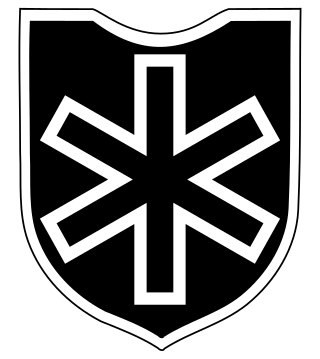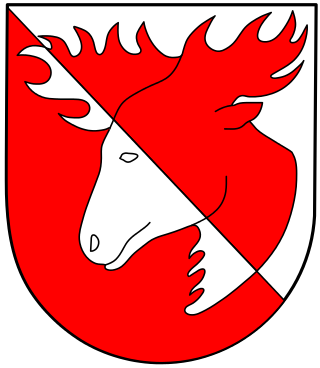
The 6th SS Mountain Division Nord was a World War II mountain infantry division of the Waffen-SS, the military wing of the German Nazi Party, primarily consisting of ethnic Germans along with some Norwegian and Swiss volunteers. It was the only Waffen-SS division to operate in the Arctic Circle.
The 3rd Mountain Division was a formation of the German Wehrmacht during World War II. It was created from the Austrian Army's 5th and 7th Divisions following the Anschluss in 1938.

The 1st Mountain Division was an elite formation of the German Wehrmacht during World War II, and is remembered for its involvement in multiple large-scale war crimes. It was created on 9 April 1938 in Garmisch Partenkirchen from the Mountain Brigade which was itself formed on 1 June 1935.
The 4th Mountain Division was a mountain infantry division of the Heer, the army of the Wehrmacht of Nazi Germany during World War II. The division was active between October 1940 and May 1940 and participated in the Balkans campaign as well as on the Eastern Front.

The German 5th Infantry Division was formed in October 1934 and mobilized on 25 August 1939. The division's troops were garrisoned in Konstanz, Ulm, and Freiburg. When formed, the division consisted of the 1st, 2nd, and 3rd battalions of the 14th, 56th, and 75th Infantry Regiments, the 1st, 2nd, and 3rd Battalions of the 5th Artillery Regiment, the 1st battalion of the 41st Artillery Regiment, and assorted 5th Division support units.

The 1st Cossack Cavalry Division was a Cossack division of the German Army that served during World War II. It was created on the Eastern Front mostly with Don Cossacks already serving in the Wehrmacht, those who escaped from the advancing Red Army and Soviet POWs. In 1944, the division was transferred to the Waffen SS, becoming part of the XV SS Cossack Cavalry Corps, established in February 1945. At the end of the war, the unit ceased to exist.

Army Group E was a German Army Group active during World War II.

The 24th Waffen Mountain Division of the SS Karstjäger was a German mountain infantry division of the Waffen-SS, the armed wing of the German Nazi Party that served alongside but was never formally part of the Wehrmacht during World War II. At the post-war Nuremberg trials, the Waffen-SS was declared to be a criminal organisation due to its major involvement in war crimes and crimes against humanity. Named Karstjäger, the formation was one of the 38 divisions fielded by the Waffen-SS. Formed on 18 July 1944 from the SS Volunteer Karstwehr Battalion, its nominal strength was never more than theoretical and the division was soon reduced to the Waffen Mountain Brigade of the SS. Throughout its existence as a battalion, division and brigade, it was primarily involved in fighting partisans in the Karst Plateau on the frontiers of Yugoslavia, Italy, and Austria; the mountainous terrain required specialised mountain troops and equipment.

42nd Jäger Division was a light infantry formation of the German Army during World War II. It can trace its origins to the 187th Infantry Division which was based in Austria until September 1942, when it was redesignated as the 187th Reserve Division. The 187th was sent to Croatia and was redesignated the 42nd Jäger Division in January 1944. 42. Jäger-Division was formed 22 Dec 1943 in Croatia from the 187. Reserve-Division. After taking part in Operation Margarthe, in March 1944, and then returned to Yugoslavia in May. In July 1944 the division was transferred to Italy where it remained for the rest of the war and surrendered in April 1945.

104th Jäger Division was an infantry division of the Germany Army in World War II. It was formed in April 1943, by the redesignation of the 704th Infantry Division, which was itself formed in April 1941. The division served in German-occupied Yugoslavia in May 1941 where it took part in anti-partisan and security operations in the Independent State of Croatia. In April 1943, it was reorganized and redesignated the 104th Jäger Division and took part in the Battle of the Sutjeska in June 1943. Following the Italian surrender, elements from the division took part in the murder of thousands of Italians from the 33 Infantry Division Acqui in September 1943, on the Greek island of Cefalonia in one of the largest-scale German atrocities to be committed by German Army troops instead of the Waffen SS.

The 11th Infantry Division was an infantry division of the Wehrmacht that was initially founded as a cover formation during the Reichswehr era. It was active from 1934 to 1945.

The 197th Infantry Division was a Wehrmacht division in World War II. It was activated on 1 December 1939.
August Wittmann was a general in the Wehrmacht during World War II. He was a recipient of the Knight's Cross of the Iron Cross.
The SS Mountain Police Regiment 18 was initially named Mountain Police Regiment (Polizei-Gebirgsjäger-Regiment) when it was formed in 1942 from existing Order Police (Ordnungspolizei) units in order to secure the railwayline in the northern Caucasus - the withdrawal from this area made these plans obsolete. When all police battalions were merged into regiments in July 1942 the Mountain Police Regiment received Nr. 18 out of a total of 28 regiments. It remained the only mountain police regiment of the Ordnungspolizei.
The 154th Infantry Division, also known as Commander of the Replacement Troops IV, Division No. 154, 154th Reserve Division, 154th Division and 154th Field Training Division was an infantry division of the German Heer during World War II.
The 159th Infantry Division was an infantry division of the German Heer during World War II. The unit, at times designated Commander of Reserve Troops IX, 159th Division, Division No. 159, and 159th Reserve Division, was active between 1939 and 1945.
The 160th Infantry Division was an infantry division of the German Heer during World War II. The unit, at times designated Commander of Reserve Troops X, Commander of Reserve Troops X/I, 160th Division, Division No. 160, and 160th Reserve Division, was active between 1939 and 1945.
The 166th Infantry Division was an infantry division of the German Heer during World War II. The unit, at times designated Commander of Reserve Troops 2 of Wehrkreis VI
The 180th Infantry Division was an infantry division of the German Heer during World War II. The unit, at times designated Commander of Reserve Troops X/II, 180th Division, Division No. 180, and Operation Division No. 180, was active between 1939 and 1945.
The 182nd Infantry Division was an infantry division of the German Heer during World War II. The unit, at times designated Commander of Reserve Troops XII/II, 182nd Division, Division No. 182, 182nd Replacement Division, Division Nancy,Division Gümbel, Division Karl, and 182nd Reserve Division, was active between 1939 and 1945.










